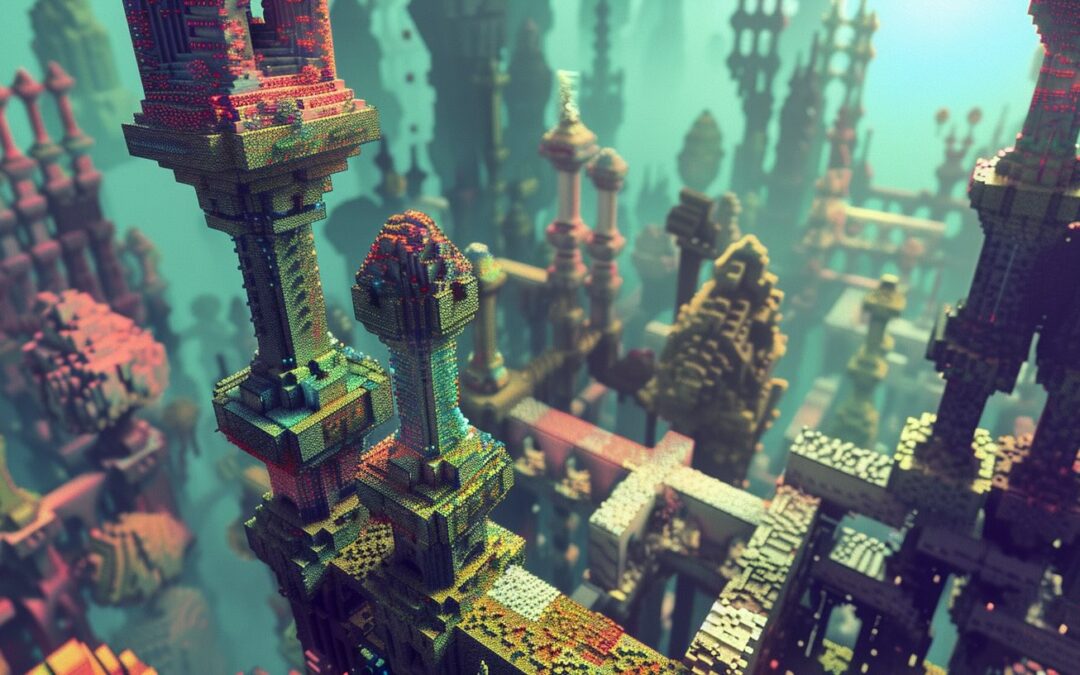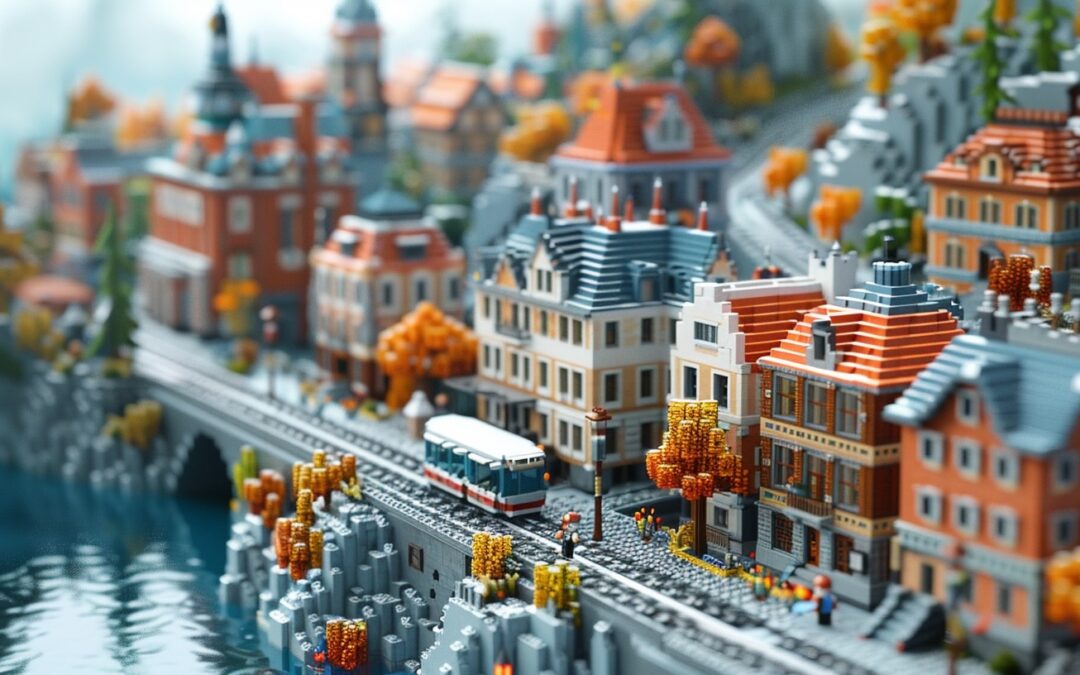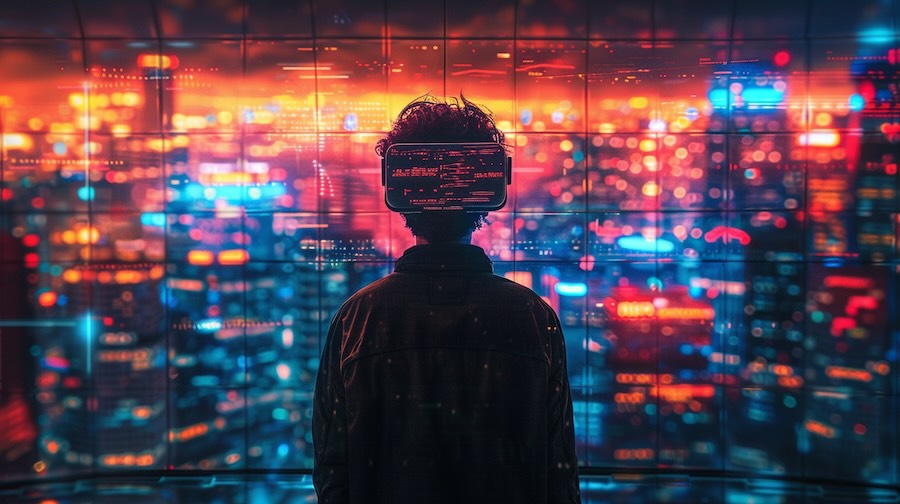Are you interested in creating your own NFT avatars for the metaverse? Do you want to use a free and easy-to-use tool that lets you design, animate, and export your voxel creations? If yes, then this blog post is for you. In this post, we will show you how to create NFT avatars with VoxEdit, a voxel editor developed by The Sandbox team.
Introducing the EU-funded project “V2B: Creating NFT Opportunities on Metaverse for Art VET Trainees” and our project reference number: 2022-1-DE02-KA210-VET-000080828. Coordinated by L4Y Learning for Youth GmbH in collaboration with Adana Cukurova Guzel Sanatlar and EMC Services Ltd, this blog post “Creating Metaverse NFTs: A Step-by-Step Guide for Young Innovators” serves as a captivating introduction. Discover how this project aims to revolutionize the future of digital assets and creativity. Explore the project’s homepage for more information and exciting updates.
This blog post covers downloading and installing VoxEdit, creating voxel models, animating them with bones and key frames, and exporting them as NFTs for metaverse platforms. Consequently, by the end of this post, you will have a basic understanding of how to use VoxEdit and how to create your own NFT avatars. Let’s start!
NFT avatars with VoxEdit: Learning Objectives
By the end of this module, learners should be able to:
- Understand the purpose and capabilities of VoxEdit for creating and animating voxel models, and identify its significance in the NFT space.
- Successfully download, install, and navigate VoxEdit to start a new project, focusing on key features such as tools and colors for model creation.
- Create, animate, and save voxel models by employing features like skeletons and keyframes within VoxEdit.
- Export the created or animated voxel models from VoxEdit, and understand the process to convert these into NFTs, including uploading to a platform and setting up the pricing and description.
- Summarize the critical steps for creating NFT avatars using VoxEdit, and optionally understand ways to test, share, and promote the created NFTs.
NFT Avatars with VoxEdit: What is VoxEdit, and why use it for NFT avatars?
Firstly, VoxEdit is a 3D modelling and animation software designed by the Sandbox team for gaming in a blockchain-powered metaverse, enabling the creation, rigging, and animation of complex shapes.
One of the main features of VoxEdit is that it enables you to create NFT avatars with voxels. NFTs are non-fungible tokens that are unique, indivisible, and non-interchangeable. They are minted on the blockchain and can be used to prove digital ownership and the authenticity of in-game assets. Above all, NFT avatars are digital representations of yourself or your characters that you can use in the metaverse.
VoxEdit is a great tool for creating NFT avatars because it is free, easy-to-use, and powerful. You can design your own voxel models from scratch, or use templates and presets. You can also rig and animate your models with bones and key frames, creating dynamic and expressive movements. Likewise, you can export your models as NFTs and sell them on The Sandbox’s marketplace, or use them in The Sandbox or other metaverse platforms.
Most importantly, VoxEdit offers NFT avatar creators a platform to unleash creativity, create unique art, monetize their creations, and join a vibrant community of artists and gamers sharing their work.
Do you want to use VoxEdit to make NFT avatars? You can download the software for free from their official website. You can also check out their online academy, where you can find tutorials, tips, and tricks on how to use VoxEdit effectively. Not only that, but you can also participate in contests and challenges to showcase your skills and win prizes. Start your NFT avatar journey today with VoxEdit!
NFT Avatars with VoxEdit: How to Download and Install VoxEdit?
In this part, we will show you how to download and install VoxEdit on your Windows or Mac computer. If you want to download and install VoxEdit, here are the steps you need to follow:
NFT Avatars with VoxEdit: Go to the VoxEdit website and click on the Download Now button.
- You will be redirected to a page where you can choose the version of VoxEdit that suits your operating system (Windows or Mac).
- Click on the Download VoxEdit button for your chosen version and wait for the file to be downloaded. The file size is about 200 MB, so it may take some time depending on your internet speed.
- Once the file is downloaded, locate it in your downloads folder and double-click on it to run the installer. You may need to grant permission for the installer to make changes to your device.
- Follow the instructions on the installer wizard to complete the installation process. You can choose the destination folder where you want VoxEdit to be installed, as well as create a desktop shortcut for easy access.
- After installation, launch VoxEdit from the start menu or desktop shortcut. A welcome screen appears, allowing users to sign in with their email or The Sandbox account.
- When you sign in to VoxEdit, which offers features like Modeller, Animator, Block Editor, tutorials, documentation, and community forums, Create voxel models using tools, import existing models in shape and color, and edit them.
- Click the Animator button to rig and animate models, adjust position, rotation, and scale, and preview and export animations as GIFs or videos.
- To create blocks for The Sandbox’s games, use the Block Editor button, place voxels, assign properties, test in various environments, and export as JSON files.
- To mint and sell your models as NFTs, click on the NFTs button. You will see a dashboard where you can view your creations, upload them to The Sandbox’s marketplace, and manage your transactions.
Congratulations! Finally, you have successfully downloaded and installed VoxEdit on your device. Now, you can unleash your creativity and make amazing voxel-based NFTs with VoxEdit!
NFT Avatars with VoxEdit: How to Create a Voxel Model with VoxEdit
Voxel models are 3D models made of small cubes called voxels, which are similar to pixels in 2D images. Voxel models can be used for creating games, animations, NFTs, and more. We will show you how to create a voxel model with VoxEdit in nine easy steps.
Step 1: Launch VoxEdit and create a new project
Once you have installed VoxEdit, launch it, and you will see the main interface. To create a new project, click on the New button in the top left corner. You will be asked to choose a name and a size for your project. The size determines how many voxels you can use in your model. For example, if you choose 32x32x32, you will have a cube of 32 voxels in each dimension. You can also change the size later if you need more or less voxels.
Step 2: Choose a tool and a colour
On the left side of the interface, you will see the toolbar, where you can choose different tools to edit your model. The most basic tool is the Pencil, which allows you to add or remove voxels by clicking on them. You can also use the Brush, which adds or removes multiple voxels at once; the Line, which draws a straight line of voxels; the Shape, which creates geometric shapes like spheres or cylinders; and the Pattern, which fills an area with a predefined pattern of voxels.
On the right side of the interface, you will see the colour palette, where you can choose the colour of your voxels. You can also create your own custom colours by clicking on the “+” button and adjusting the RGB values. To apply a colour to your voxels, simply select it from the palette and use one of the tools from the toolbar.
Step 3: Model your object
Now that you have chosen a tool and a colour, you can start modelling your object. You can use any reference image or sketch that you want, or just use your imagination. To move around your model, you can use the mouse wheel to zoom in or out and the right mouse button to rotate or pan. You can also use the arrow keys or the WASD keys to move along the X, Y, and Z axes.
To add voxels to your model, just click on a space with one of the tools. To remove voxels from your model, hold down the Ctrl key and click on an existing voxel with one of the tools. You can also use the Rubber/Eraser tool to remove voxels without holding down any keys.
Step 4: Save your model
When you are happy with your model, you can save it by clicking on the Save button in the top left corner. You will be asked to choose a name and a location for your model file. The model file has a .vox extension and can be opened by VoxEdit or other voxel editors.
Step 5: Create a skeleton (optional)
If you want to animate your model later, you need to create a skeleton for it. A skeleton is a set of bones that define how your model can move and deform. To create a skeleton, click on the Animator tab in the top-right corner of the interface. You will see a new window where you can add bones to your model.
To add a bone, click on the Add Bone button on the left side of the window. A bone will appear in the centre of your model. You can move it by dragging it with the left mouse button, rotate it by dragging it with the right mouse button, and scale it by dragging it with the middle mouse button. You can also use the arrow keys or the WASD keys to move it along the X, Y, and Z axes.
To connect two bones together, select one bone and then click on another bone with the left mouse button. A joint will appear between them. You can adjust the joint angle by dragging it with the right mouse button. To assign voxels to a bone, select a bone and then click on one or more voxels with the left mouse button while holding down the Shift key. The selected voxels will change their colour to match the bone colour. To delete a bone or a joint, select it and then press the Delete key.
Step 6: Save your skeleton (optional)
When you are done creating your skeleton, you can save it by clicking on the Save button on the top left corner of the window. You will be asked to choose a name and a location for your skeleton file. The skeleton file has a .skel extension, and you can open it by VoxEdit or other voxel editors.
Step 7: Create an animation (optional)
If you want to animate your model, you need to create an animation for it. An animation is a sequence of frames that shows how your model changes over time. To create an animation, click on the Animator tab in the top-right corner of the interface. You will see the same window as before, but with a timeline at the bottom.
To add a frame to your animation, click on the Add Frame button on the left side of the timeline. A frame will appear at the end of the timeline. You can move it by dragging it with the left mouse button, and you can delete it by pressing the Delete key.
To edit a frame, select it by clicking on it with the left mouse button.
To preview your animation, click on the Play button on the right side of the timeline. You will see your model move according to your frames. You can adjust the speed of your animation by dragging the slider below the timeline.
Step 8: Save your animation (optional)
When you are happy with your animation, you can save it by clicking on the Save button in the top left corner of the window. You will be asked to choose a name and a location for your animation file. The animation file has a .anim extension and can be opened by VoxEdit or other voxel editors.
Step 9: Export your model (optional)
Finally, if you want to use your model in other applications or platforms, don’t forget to export it in a different format. VoxEdit supports exporting to .obj, .gltf, .glb, and .fbx formats, which are compatible with most 3D software and game engines.
To export your model, click on the Export button in the top left corner of the interface. You will see a new window where you can choose the format and options for your export. For example, you can choose whether to export only the model or the skeleton and animation, whether to include textures or not, and whether to optimize or not.
Once you have chosen your options, click on the Export button at the bottom of the window. You will be asked to choose a name and a location for your export file. The exported file will have the extension that corresponds to the format that you chose.
Now, you have created a voxel model with VoxEdit! You can now use it for whatever you want, such as creating games, animations, NFTs, and more. Have fun and keep creating!
NFT Avatars with VoxEdit: How to Animate Your Voxel Model with VoxEdit
In this part, we will explain how to animate your voxel model with VoxEdit.
NFT Avatars with VoxEdit: Launch VoxEdit and open your model
Once you have installed VoxEdit, launch it, and you will see the main interface. To open your model, click on the Open button in the top left corner. You will be asked to choose a model file from your computer. The model file can be produced by VoxEdit or other voxel editors and has a .vox extension.
Create a skeleton for your model
Above all, if you want to animate your model, you need to create a skeleton for it. A skeleton is a set of bones that define how your model can move and deform. To create a skeleton, click on the Animator tab in the top-right corner of the interface. You will see a new window where you can add bones to your model.
To add a bone, click on the Add Bone button on the left side of the window. A bone will appear in the centre of your model. You can move it by dragging it with the left mouse button, rotate it by dragging it with the right mouse button, and scale it by dragging it with the middle mouse button. You can also use the arrow keys or the WASD keys to move it along the X, Y, and Z axes.
To connect two bones together, select one bone and then click on another bone with the left mouse button. A joint will appear between them. You can adjust the joint angle by dragging it with the right mouse button.
To assign voxels to a bone, select a bone and then click on one or more voxels with the left mouse button while holding down the Shift key. The selected voxels will change their colour to match the bone colour.
To delete a bone or a joint, select it and then press the Delete key.
Save your skeleton
When you are done creating your skeleton, you can save it by clicking on the Save button in the top left corner of the window. You will be asked to choose a name and a location for your skeleton file. The skeleton file has a .skel extension and can be opened by VoxEdit or other voxel editors.
Create an animation for your model
Firstly, you need to create an animation for your model. An animation is a sequence of frames that shows how your model changes over time. To create an animation, click on the Animator tab in the top-right corner of the interface. You will see the same window as before but with a timeline at the bottom.
Secondly, to add a frame to your animation, click on the Add Frame button on the left side of the timeline. A frame will appear at the end of the timeline. You can move it by dragging it with the left mouse button, and you can delete it by pressing the Delete key.
Thirdly, to edit a frame, select it by clicking on it with the left mouse button. The main window displays your model and skeleton, allowing you to manipulate bones, rotate, scale, and edit voxels using tools like Pencil, Brush, Line, Shape, and Pattern.
Finally, to preview your animation, click on the Play button on the right side of the timeline. You will see your model moving according to your frames. You can adjust the speed of your animation by dragging the slider below the timeline.
Save your animation
When you are happy with your animation, you can save it by clicking on the Save button in the top left corner of the window. You will be asked to choose a name and a location for your animation file. The animation file has a .anim extension, which you can open with VoxEdit or other voxel editors.
Export your animation (optional)
If you want to use your animation in other applications or platforms, firstly, you need to export it in a different format. VoxEdit supports exporting to .obj, .gltf, .glb, .gltf, .glb, and .fbx formats, which are compatible with most 3D software and game engines.
To export your animation, click on the Export button in the top left corner of the interface. You will see a new window where you can choose the format and options for your export. For example, you can choose whether to export only the animation or also the model and skeleton, whether to include textures or not, and whether to optimize or not.
Once you have chosen your options, click on the Export button at the bottom of the window. You will be asked to choose a name and a location for your export file. The exported file will have the extension that corresponds to the format that you chose.
Test your animation (optional)
If you want to test your animation in a game engine or a 3D viewer, you need to import it to the application of your choice. For example, you can use Unity, Unreal Engine, Sketchfab, or Voxatron to load and play your animation. Each application has its own way of importing and displaying voxel animations, so you may need to follow some specific steps or adjust some settings to make it work properly.
Share your animation (optional)
If you want to share your animation with others, you need to upload it to a platform that supports voxel animations. For example, you can use The Sandbox, VoxEdit Marketplace, OpenSea, or VoxelArt to showcase and sell your animation as an NFT (non-fungible token). Each platform has its way of uploading and displaying voxel animations, so you may need to follow some specific steps or adjust some settings to make it work properly.
Now, you have animated your voxel model with VoxEdit! You can now use it for whatever you want, such as creating games, animations, NFTs, and more. Have fun and keep animating!
NFT Avatars with VoxEdit: How to Export Your Voxel Model as an NFT?
NFTs can be used to certify the ownership and authenticity of various kinds of digital creations, such as art, music, games, and more. If you have created a voxel model with VoxEdit or another voxel editor, you may want to export it as an NFT and sell or trade it on a platform that supports voxel NFTs. In this episode, we will show you how to export your voxel model as an NFT.
NFT Avatars with VoxEdit: Export your model as an NFT
To export your model as an NFT, you need to click on the Export button on the top left corner of any window. You will see a new window where you can choose the format and options for your export. For example, you can choose whether to export only the model or also the skeleton and animation, whether to include textures or not, and whether to optimize or not.
The format that you need to choose depends on which platform you want to use for selling or trading your NFT. Some platforms support only certain formats, while others support multiple formats. Here are some examples of popular platforms that support voxel NFTs:
- The Sandbox: A virtual world where you can create, play, and monetize your voxel creations. It supports .vox, .gltf, and .glb formats.
- VoxEdit Marketplace: A marketplace where you can buy and sell voxel NFTs created with VoxEdit. It supports .vox, .gltf, and .glb formats.
- OpenSea: The largest NFT marketplace where you can buy and sell any kind of digital asset. It supports .obj, .gltf, .glb, and .fbx formats.
- VoxelArt: A platform where you can create, share, and collect voxel art. It supports the .vox format.
Once you have chosen your format and options, click on the Export button at the bottom of the window. You will be asked to select a name and a location for your export file. The export file will have the extension corresponding to your chosen format.
Upload your export file to the platform of your choice
To upload your export file to the platform of your choice, you need to follow the instructions and requirements of each platform. For example, some platforms may ask you to create an account, connect a wallet, pay a fee, or provide some metadata for your NFT. Each platform has its own way of uploading and displaying voxel NFTs, so you may need to follow some specific steps or adjust some settings to make it work properly.
Set a price and a description for your NFT
To set a price and a description for your NFT, please fill in the information the platform asks you to provide. For example, some platforms may ask you to choose a currency, a fixed price, an auction, a royalty percentage, or a collection name for your NFT. You may also need to write a title, a description, and some tags for your NFT to make it more attractive and searchable. You can also add some images or videos to showcase your NFT.
Publish your NFT
To publish your NFT, you need to click on the button that the platform provides to finalize your listing. For example, some platforms may ask you to confirm your listing, sign a transaction, or wait for approval before your NFT goes live. Once published, your NFT will be available to other users who can browse, purchase, or place a bid on it.
Promote your NFT (optional)
To promote your NFT, you may want to share it on social media or other channels where potential buyers or collectors can see it. For example, you can post a link or an image of your NFT on Twitter, Instagram, Reddit, Discord, or other platforms where voxel art enthusiasts gather. You can also use hashtags or keywords related to voxel art or NFTs to increase your visibility and reach.
In this way, you have exported your voxel model as an NFT! You can now enjoy the benefits of owning or selling a unique digital asset on the blockchain. You can also keep creating more voxel models and exporting them as NFTs to expand your collection or portfolio. Have fun and keep creating!
NFT Avatars with VoxEdit: Conclusion of The Step-by-Step Guide
The main steps for creating an NFT avatar with VoxEdit and exporting it to the marketplace are summarised.
- Firstly, create or import your voxel model in the modeller mode of VoxEdit. You can use the various tools available to shape your model and add details. You can also watch some tutorial videos on how to use VoxEdit here: VoxEdit Tutorials.
- Secondly, separate your model into different pieces in the rigger mode of VoxEdit. This is necessary to make your model compatible with the game engine and to avoid collision issues. You can duplicate your model and delete the unwanted parts to create separate pieces. You can also check out this tutorial on how to do this: Separating your asset into pieces.
- Thirdly, rig your model by creating a skeleton and assigning each bone to a model part. This will allow you to animate your model and make it more dynamic. You can also use the library of pre-made animations or create your own.
- Finally, export your model to the marketplace and convert it into a non-fungible token (NFT). This will make your model unique and secure on the blockchain. You can also share your model with other users and earn rewards for your creations.
Shortly, creating NFT avatars with VoxEdit is a fun and easy way to express your creativity and join the metaverse. You can download VoxEdit here: VoxEdit Download. And you can also join the Creator Fund here: [Creator Fund]. We hope you enjoyed this article and learned something new. Thank you for reading!
Resources
- VoxEdit website. (n.d.). VoxEdit.
- The Sandbox – A Decentralized Gaming Platform Made By Players. (n.d.). The Sandbox.
- TheSandboxGame. (2021, February 26). VoxEdit Tutorial – Model your own avatar or mix & match [YouTube].
- TheSandboxGame. (2021b, April 3). Create NFT Assets in VoxEdit – The Sandbox Saturday Stream [YouTube].









